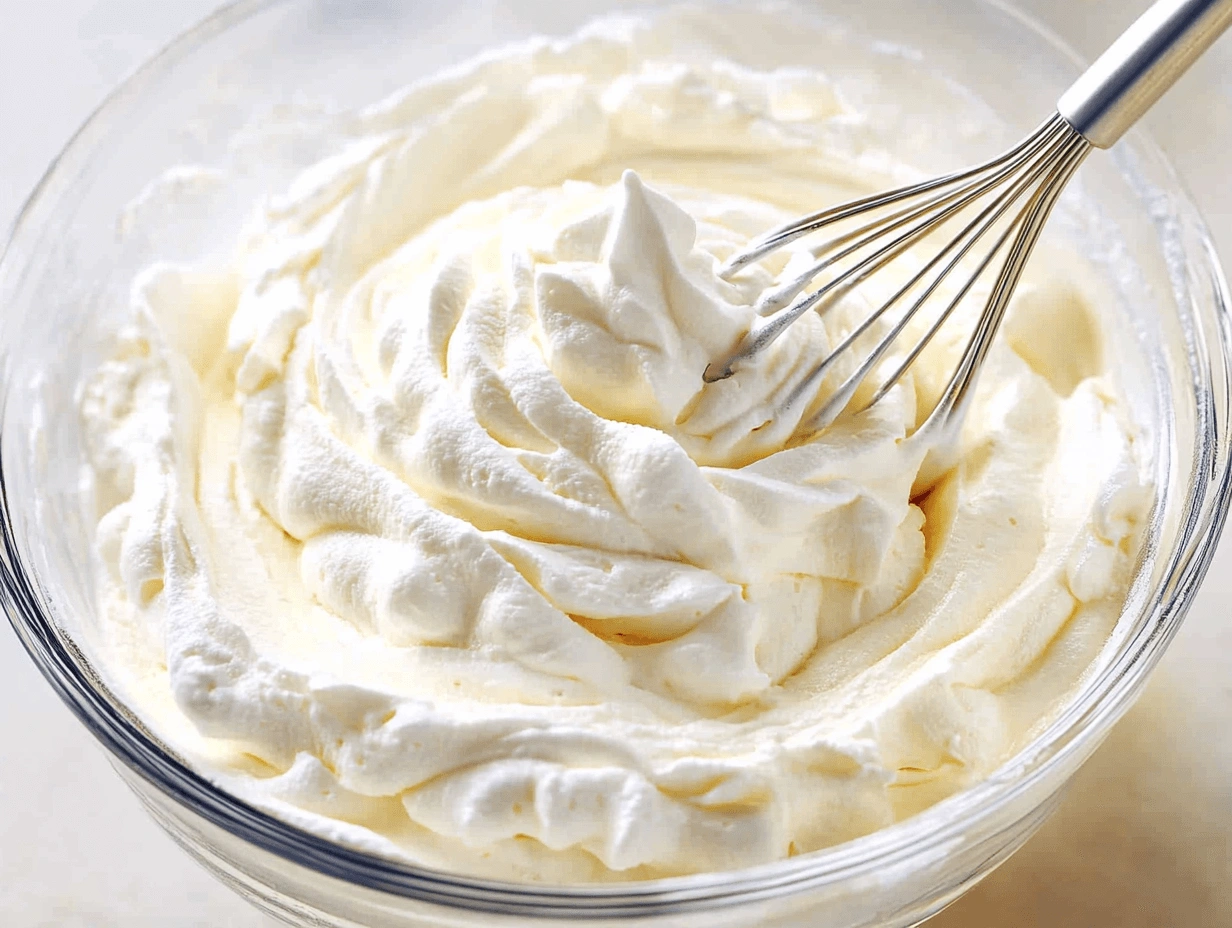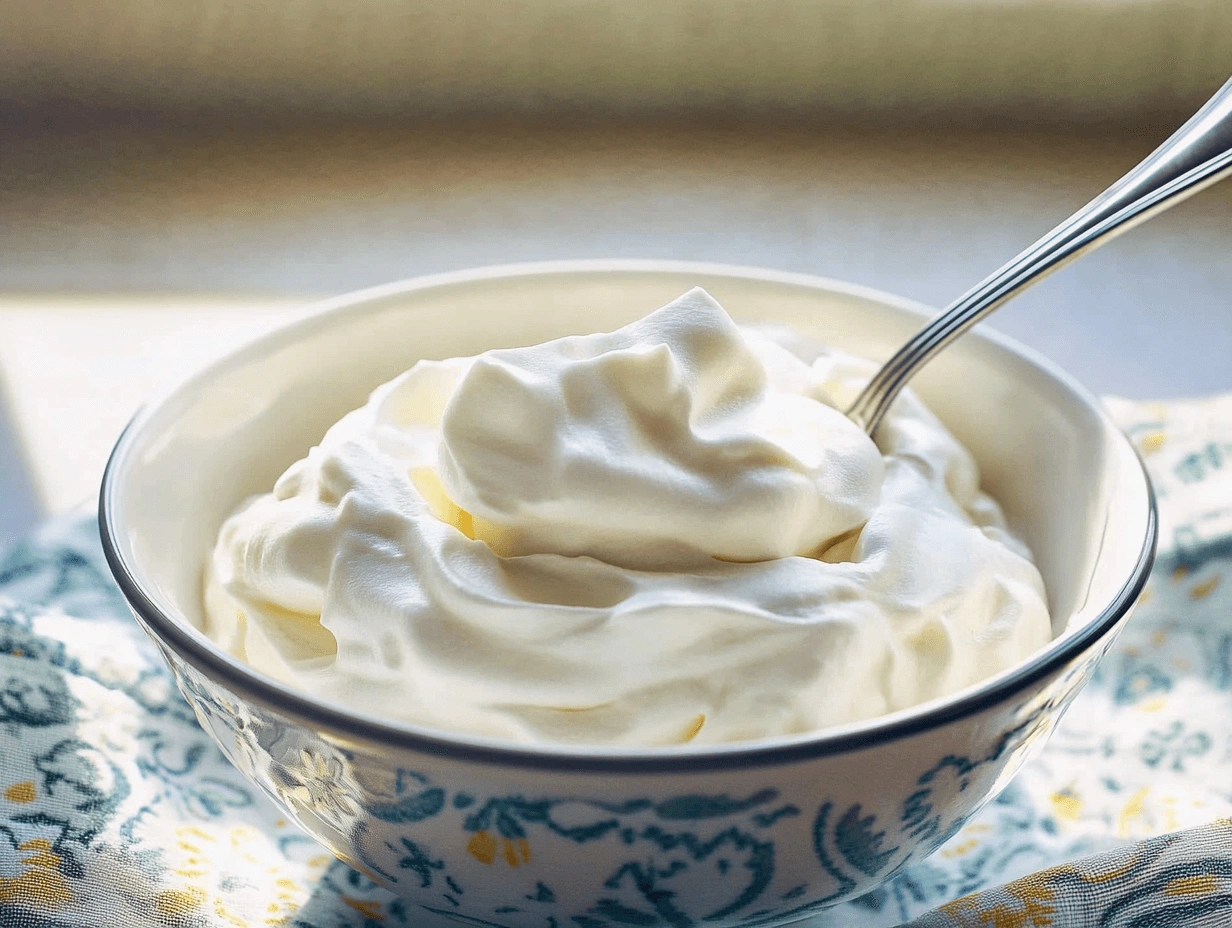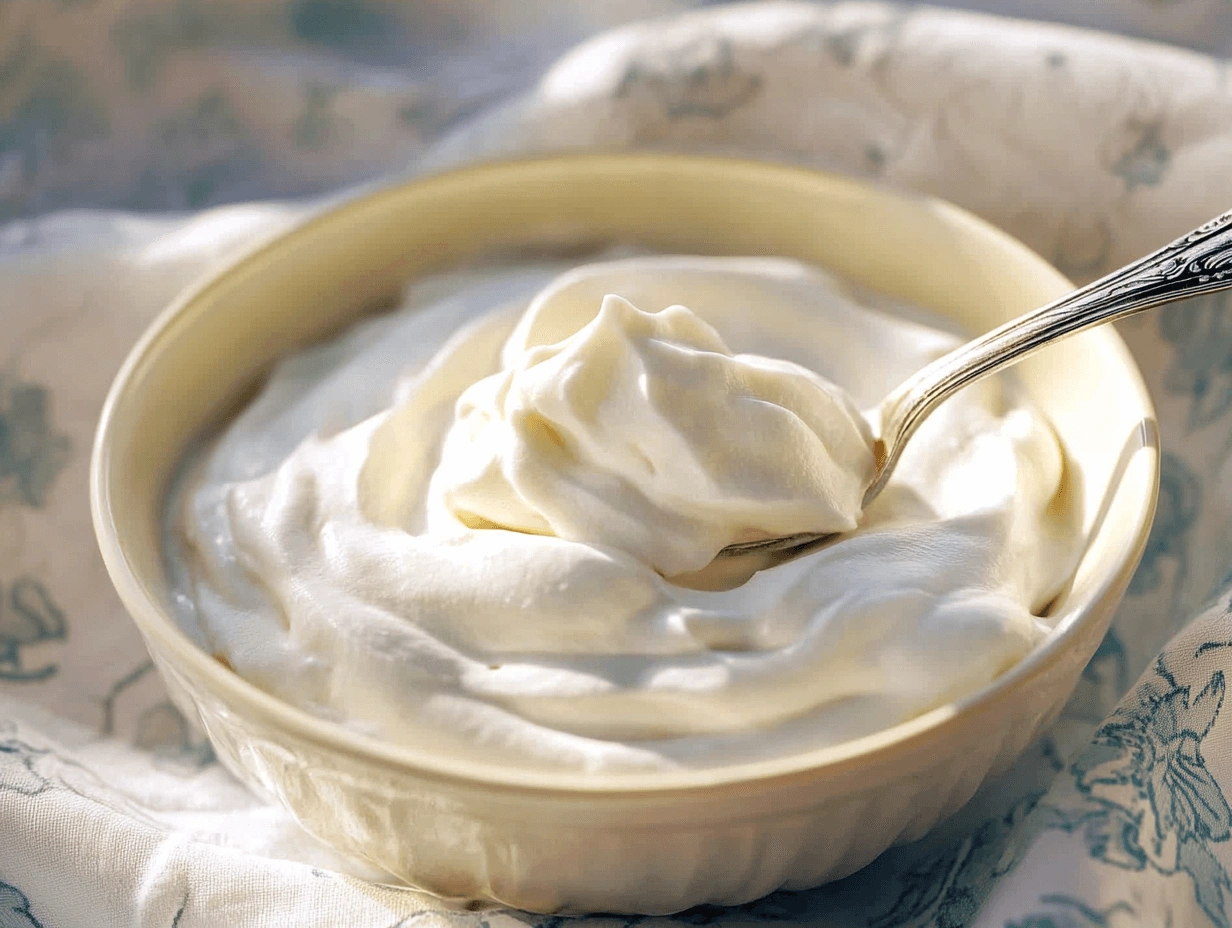Introduction
Cool Whip has long been a favorite among dessert lovers because of its light and fluffy texture. It is often used as a topping for pies, cakes, and other treats, adding a creamy and sweet finishing touch. However, many wonder, “Can Cool Whip be used in baking?” This is a common question, as baking typically involves heat, which might alter Cool Whip’s composition and affect its performance.
This guide dives into the details of using Cool Whip in baked recipes. It also provides practical tips, delicious recipes, and best practices to help you determine the best ways to incorporate Cool Whip into your culinary creations. Whether you’re a seasoned baker or a novice, this guide will offer valuable insights into working with this versatile ingredient.
What Is Cool Whip, and Why Consider It for Baking?
What Makes it Unique?
Cool Whip is a whipped topping made from water, hydrogenated vegetable oil, high-fructose corn syrup, and stabilizers such as xanthan gum. These ingredients contribute to its smooth, stable texture, making it a reliable choice for dessert recipes. Unlike traditional whipped cream, Cool Whip is designed to maintain its form even after freezing or extended storage.
Furthermore, its stability allows it to hold up better in layered desserts. However, when asking Can Cool Whip be used in baking, it’s essential to consider that its synthetic ingredients may yield different results compared to natural alternatives. Its ability to withstand freezing and storage can make it a practical option for certain recipes, but it may not perform as well under direct heat in baking applications.
Reasons to Choose Cool Whip in the Kitchen
How It Differs from Traditional Whipped Cream
Cool Whip and whipped cream both bring a light, airy texture to desserts, but each serves a distinct role.
- Cool Whip: Long shelf life, consistent texture, and convenience.
- Whipped Cream: Fresher taste, richer flavor, and better suited for heat-sensitive recipes. Because of these differences, it is important to choose the right option based on the recipe and desired outcome.
Can Cool Whip Be Used in Baking Recipes?

How Heat Affects Its Performance
When exposed to high temperatures, Cool Whip’s water content may cause it to separate. This reaction can alter the texture and structure of baked goods. For this reason, those asking Can Cool Whip be used in baking should note that it is not ideal for recipes involving prolonged or direct heat.
However, when incorporated into batters or fillings, it can enhance moisture and lightness. For example, folding Cool Whip into a cake batter can result in a fluffier texture. Similarly, using it as a filling for pies or trifles works well since the heat exposure is minimal.
Tips for Success
- Use in Low-Heat Recipes: Cool Whip performs better in recipes that bake at lower temperatures.
- Combine with Stabilizers: Mixing Cool Whip with ingredients like cream cheese or gelatin can improve its performance in baked desserts.
- Fold Gently: To retain its airy texture, fold Cool Whip into mixtures instead of overmixing.
The Best Types of Recipes for Cool Whip
Cool Whip shines in certain baked and no-bake recipes:
- Layered Cakes: As a filling or frosting, it adds a creamy texture and appealing lightness.
- No-Bake Cheesecakes: Cool Whip blends seamlessly with cream cheese for a smooth and velvety filling.
- Pudding Desserts: Adding Cool Whip to puddings creates a mousse-like consistency.
Popular Recipes Featuring Cool Whip
Adding Lightness to Cakes and Pies
Cool Whip adds a delightful touch to cakes and pies, especially in recipes that emphasize lightness. For example:
- Angel Food Cake: Spread Cool Whip between layers of angel food cake for a fluffy and sweet finish.
- Chocolate Mousse Pie: Combine Cool Whip with melted chocolate and a dash of vanilla for a decadent pie filling.
By incorporating Cool Whip into these recipes, you can achieve desserts that are both visually appealing and delicious.
Creative Approaches in the Kitchen
Cool Whip’s versatility allows bakers to experiment with innovative recipes. Some examples include:
- Cool Whip Cookies: These soft and chewy cookies use Cool Whip as a key ingredient to create a light texture. Try the recipe here.
- Icebox Cakes: Layer Cool Whip with graham crackers, fruits, and chocolate for an easy no-bake treat.
- Pudding-Based Desserts: Folding Cool Whip into pudding mixtures creates a creamy and airy mousse.
For more ideas, check out the Ultimate Guide to Perfect Rice Krispie Treats, where you’ll find another classic way to incorporate light and fluffy ingredients into desserts.
Challenges and Solutions
Managing Heat Sensitivity
Baking with Cool Whip presents some challenges due to its unique composition. The water and oil content, along with stabilizers like xanthan gum, can lead to separation or texture changes when exposed to high temperatures. For those wondering Can Cool Whip be used in baking, it’s important to note that it is unsuitable for recipes requiring prolonged baking at high heat.
However, when properly incorporated, Cool Whip can enhance baked goods with its light and airy quality. The key is understanding how Cool Whip reacts to heat. In most cases, it works best when folded into batters that don’t require significant structural integrity or as an ingredient in low-temperature recipes like soufflés or casseroles.
How to Adjust Recipes to Include Cool Whip in Baked Goods
To use Cool Whip in baking:
- Fold Gently: Incorporate Cool Whip into the batter with a folding motion to preserve its airy texture.
- Reduce Liquid Ingredients: Since Cool Whip adds moisture, slightly reduce other liquid components in the recipe.
- Choose Low-Heat Recipes: Use Cool Whip in recipes baked at lower temperatures, such as custards or slow-baked cakes.
- Stabilize with Other Ingredients: Pair Cool Whip with cream cheese or pudding mix to help maintain consistency during baking.
For those asking Can Cool Whip be used in baking, it’s worth noting that with minor adjustments, substituting Cool Whip for whipped cream in recipes can be seamless. Try incorporating it into no-crust pies or soft cakes to achieve a light, airy texture while keeping the structure intact.
Can Cool Whip Be Used as a Frosting in Baking?

Techniques for Using Cool Whip as Frosting in Baked Desserts
Cool Whip is a popular choice for frosting due to its ease of application and ability to provide a fluffy finish to desserts. For those wondering Can Cool Whip be used in baking, it’s also an excellent option for decorative touches. To use it effectively:
- Apply on Cooled Desserts: Always ensure cakes or baked goods are fully cooled before adding Cool Whip frosting to avoid melting or separation.
- Stiffen with Additives: Combine Cool Whip with powdered sugar or a stabilizer like unflavored gelatin to create a thicker and more durable frosting.
- Layer Strategically: Use Cool Whip as a light topping or inner layer, steering clear of heavy decorations that might compress its airy texture.
For instance, using Cool Whip frosting on a delicate sponge cake enhances its presentation and complements its flavor, proving that Can Cool Whip be used in baking is a question of creative and careful application.
Tips to Keep Cool Whip Stable During Baking or Serving
To keep Cool Whip frosting stable and answer the question Can Cool Whip be used in baking, follow these tips:
- Chill Before Serving: Always refrigerate desserts with Cool Whip frosting until it’s time to serve to maintain its texture.
- Avoid Direct Sunlight: Keep desserts in a cool environment to prevent the frosting from melting.
- Combine for Strength: Mix Cool Whip with cream cheese or mascarpone to achieve a thicker and sturdier consistency.
These techniques ensure that Cool Whip can be effectively used for frosting in a variety of baking and dessert applications.
For more tips on frosting techniques, refer to this Cool Whip Cookie Guide.
Can Cool Whip Be Used as a Cake Filling in Baking?
How to Prepare Cool Whip for Use as a Cake-Filling
When used as a filling, Cool Whip adds a creamy and smooth layer between cake tiers. For those wondering Can Cool Whip be used in baking, here are tips to prepare it effectively:
- Stabilize the Mixture: Blend Cool Whip with instant pudding mix or cream cheese to prevent the filling from becoming overly runny.
- Chill Before Use: Allow the mixture to firm up in the refrigerator for at least 30 minutes before applying.
- Add Flavor Enhancers: Customize the filling by incorporating vanilla extract, cocoa powder, or fruit purees for added flavor.
By following these steps, you can ensure the filling remains light and stable while providing a perfect complement to your cake layers, demonstrating that Can Cool Whip be used in baking depends on thoughtful preparation.
Layering Cool Whip in Cakes for a Professional Finish
To achieve a professional look with Cool Whip, especially for those wondering Can Cool Whip be used in baking, follow these techniques:
- Use a Piping Bag: Transfer Cool Whip into a piping bag for precise, neat application.
- Spread Evenly: Smooth each layer with a spatula to ensure even distribution and an elegant finish.
- Refrigerate Immediately: After assembling the cake, refrigerate it promptly to maintain its structure and freshness.
For a delicious example, try using Cool Whip as a filling in a black forest cake. Its light, airy texture complements the rich chocolate layers perfectly, showing that Can Cool Whip be used in baking is best answered with thoughtful, professional preparation techniques.
Advantages of Using Cool Whip in Baking
Why Bakers Choose Cool Whip for Texture and Flavor
Cool Whip is favored for its ability to add both texture and flavor without requiring complex preparation. It enhances desserts by:
- Adding Moisture: Prevents baked goods from drying out.
- Creating Lightness: Provides an airy consistency, especially in cakes and pies.
- Balancing Flavors: Its mild sweetness complements rich or tangy ingredients like chocolate or citrus.
These advantages make Cool Whip an accessible choice for both novice and experienced bakers.
How Cool Whip Simplifies Dessert Preparation
Cool Whip is also incredibly convenient. For those wondering Can Cool Whip be used in baking, its ready-to-use nature sets it apart from traditional whipped cream, which requires whipping. Cool Whip’s consistent texture ensures reliable results in various recipes.
For example, when preparing a layered trifle, Cool Whip not only reduces preparation time but also provides a polished, professional appearance. This versatility makes it a popular ingredient, proving that Can Cool Whip be used in baking often depends on its convenience and adaptability to different dishes.
Challenges of Baking with Cool Whip
Can Cool Whip Withstand Heat in Baking? Potential Pitfalls
One of the most significant challenges when addressing Can Cool Whip be used in baking is its reaction to heat. Its high water content and stabilizers can cause separation or a loss of structure when exposed to prolonged or high temperatures, potentially leading to baked goods with uneven textures or sogginess.
Another challenge stems from the hydrogenated oils and emulsifiers in Cool Whip, which are not formulated to withstand the intense heat of a conventional oven. Recipes incorporating Cool Whip must account for these limitations to achieve successful results.
Solutions for Common Problems When Baking with Cool Whip
Despite these challenges, there are effective strategies to mitigate potential pitfalls:
- Incorporate Cool Whip Into Low-Heat Recipes: Recipes that bake at low temperatures or require minimal heat exposure, such as cheesecakes or soufflés, are better suited for Cool Whip.
- Use Cool Whip in Batters, Not Toppings: When baked, Cool Whip fares better as a blended ingredient in batters rather than as a standalone topping.
- Add Stabilizing Ingredients: Mixing Cool Whip with cream cheese or instant pudding mix can help it maintain its consistency during baking.
- Monitor Baking Times Closely: Shorten baking times and use a lower temperature to preserve the structure of the Cool Whip-infused mixture.
For additional guidance, explore related dessert tips in the Cool Whip Cookies Guide.
Cool Whip in No-Bake vs. Baked Desserts
Comparing the Use of Cool Whip in No-Bake and Baked Recipes
Cool Whip truly shines in no-bake recipes. Its stability, fluffy texture, and ready-to-use format make it an ideal choice for no-bake pies, cheesecakes, and trifles. No-bake desserts leverage Cool Whip’s properties without risking the texture changes that can occur during baking.
In baked recipes, however, Cool Whip’s performance depends on its role in the dish. While it can add moisture and lightness to batters, its tendency to separate under heat limits its applications. Recipes such as low-heat custards or cakes baked with care can accommodate Cool Whip, but no-bake desserts remain its stronghold.
When to Opt for No-Bake Recipes with Cool Whip
Choosing a no-bake recipe with Cool Whip is often the safest and most effective option. Here are some instances where no-bake recipes are preferable:
- Quick and Easy Preparation: Cool Whip eliminates the need for whipping or complex steps in recipes like mousse or icebox cakes.
- Heat Sensitivity: For desserts that require a creamy topping or filling, no-bake recipes prevent heat-related issues like separation.
- Perfect for Layered Desserts: Cool Whip works wonderfully in layered trifles, pudding desserts, or parfaits where no baking is required.
For a comprehensive no-bake dessert guide, consider checking out this recipe collection.
Can Cool Whip Replace Other Ingredients in Baking?
Using Cool Whip as a Substitute for Heavy Cream or Whipped Cream
Cool Whip can often be used as a substitute for heavy cream or whipped cream in specific recipes. However, due to its stabilized composition, some adjustments may be needed. Here’s how Cool Whip compares to these ingredients:
- Heavy Cream: While heavy cream provides a rich, natural flavor and texture, Cool Whip is lighter and sweeter. It works well in recipes where stability is more important than richness.
- Whipped Cream: Cool Whip’s ready-to-use form makes it a convenient alternative, though its synthetic flavor profile may differ from fresh whipped cream.
Adjusting Baking Recipes to Incorporate Cool Whip Effectively
When exploring Can Cool Whip be used in baking as a substitute, follow these tips to ensure success:
- Adjust Sweetness Levels: Cool Whip is sweeter than heavy cream or whipped cream, so reduce the added sugar in your recipe accordingly.
- Compensate for Fat Content: Add a small amount of butter or cream cheese to account for Cool Whip’s lower fat content compared to heavy cream.
- Incorporate Slowly: Fold Cool Whip gently into the mixture to maintain its airy and light texture.
Recipes like mousse, pudding pies, or light frostings demonstrate how Cool Whip can effectively replace traditional ingredients while delivering excellent results.
Final Thoughts
Recap: Can Cool Whip Be Used in Baking, and What Are Its Limitations?
Cool Whip is a versatile ingredient that adds convenience and a distinct texture to both baked and no-bake desserts. For those exploring Can Cool Whip be used in baking, it’s important to note that while its composition restricts its use in high-temperature baking, it performs exceptionally well in low-heat recipes and no-bake creations.
Bakers who understand Cool Whip’s strengths and limitations can harness its potential to craft delicious and visually stunning treats, making it a valuable addition to any dessert repertoire.
Encouragement to Experiment with Cool Whip in Your Desserts
Don’t be afraid to try Cool Whip in various dessert recipes. Whether you’re making a quick no-bake cheesecake, experimenting with pudding pies, or adding a fluffy frosting to your favorite cake, Cool Whip’s stability and ease of use make it an asset in the kitchen.
Recipes like mousse, pudding pies, or light frostings demonstrate how Cool Whip can effectively replace traditional ingredients while delivering excellent results. For further insights on using Cool Whip in various recipes, visit Bon Appétit’s homepage.

